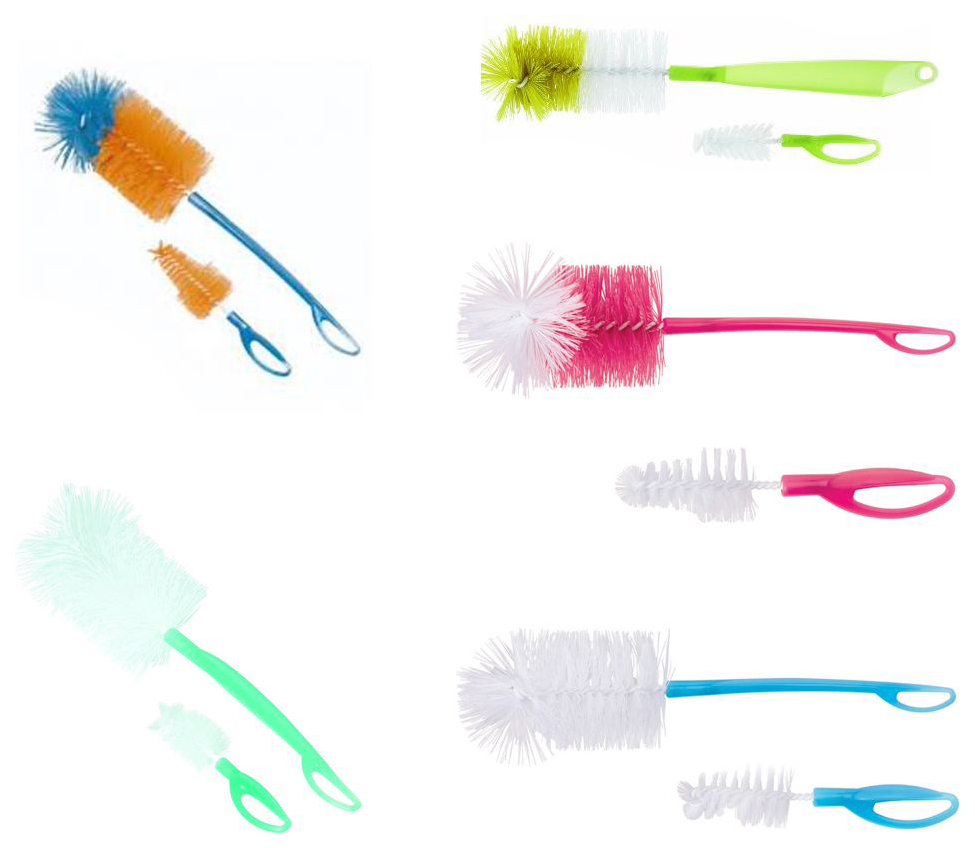Contents:
- Propagation methods for drcenas
- Propagation with apical cut
- Propagation by propagation
- Propagation by air layers
- Propagation by seeds
Dracaena is a rather unprimatic indoor palm tree, however, despite its unpretentiousness, it may lose its appeal with age. It is not worth it in this case to throw out - the dracenium can be multiplied, and it is easier to do this at home than it may seem. If everything is done correctly, it will be possible to grow a few small palms and at the same time keep the old ones.
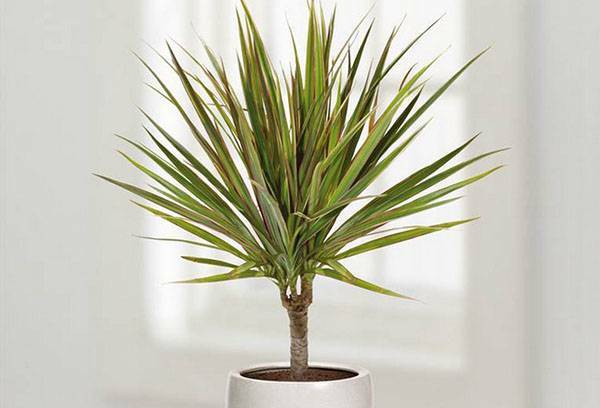
Methods of propagation of dracene
To obtain a young dracenium, there are several ways:
- from a stem cuttings;
- from the apical cut;
- from air layers;
- from seeds.
Each of these methods has its advantages and disadvantages. So, reproduction by seeds is carried out without damaging the stems. However, this method is rarely used, since not all types of dracaena blossom at home, and blooming flowers are rare - sometimes this pleasant surprise for the florist has to wait 8-10 years. Without flowers, accordingly, it is impossible to get seeds.
Reproduction by cuttings, apical or cauline, is available, but this requires cutting the palm stalk or part of it. In this case, there is a possibility that the appearance of the plant will be irreparably corrupted, and the cuttings will not take root. Despite the riskiness of this method, it is used most often, since it is the simplest.
Reproduction by air layers often allows you to maintain a good appearance of the mother plant and almost guaranteed to get a young dracen. This option is not the easiest, but with all the rules - it is quite feasible at home.
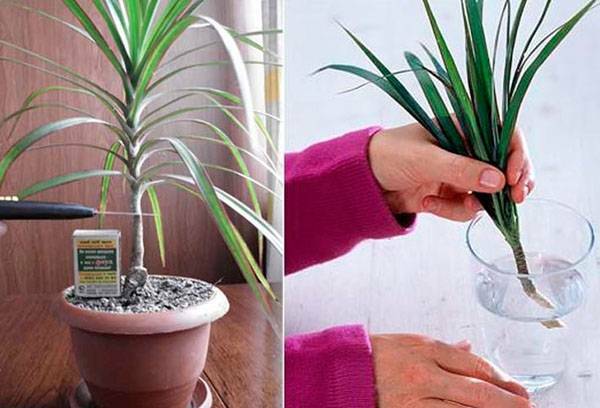
Propagation with the tip cutter
One of the easiest and relatively safe ways to get a daughter plant is to multiply the dracenium with the tip of the apex.
- With a sharp knife, cut off the top of the palm tree, covered with foliage. The knife must be sharp so that the cut is as flat as possible. The cut must be 15-18 centimeters below the edge sheet.
- Remove all old leaves from the cut stem - only a few of the freshest leaves should be left, but you can also remove them, as long as the stem does not take root, there will still not be food for the leaves.
- Root the stalk by lowering it into a container of water, in which before that it is necessary to add a little wood ash and rooting stimulants purchased in the flower shop. It is permissible to root it in a mixture of peat, sand and coal. When the plant releases roots, it's time to put it in the steamed soil for dracaena for further rooting.
Advice
Root the stem directly in steamed soil, the composition of which is tailored specifically for the cultivation of dracen.
- Create conditions that are optimal for rooting. Implied the presence of a film shelter, which should be raised every day for a quarter of an hour for ventilation. Moisten the soil regularly, so that the young roots are not dried, but not too abundantly - if the moisture is too high, the root system will not develop, but rot. The temperature in the room with the handle should be maintained at a level of 20-23 degrees.
Rooting lasts quite a long time, usually this period is three months or even longer. After rooting, the plant should be grown in the usual way.
Tip
Place the cut on the stalk of the mother plant cover with cellophane, and the plant itself watering intensively - a month later, the young shoots will appear at the cutting site, which will become the trunks of the palm.
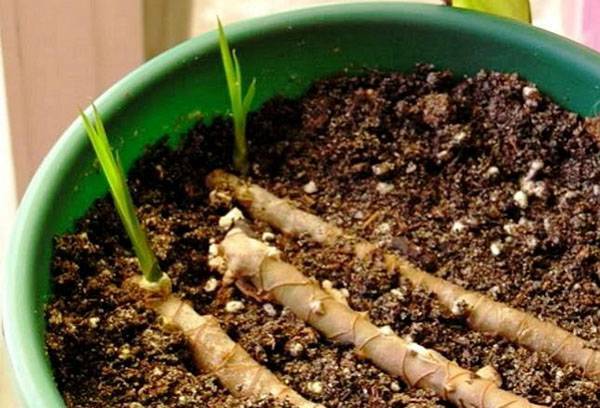
Propagation by the propagation of
An even simpler way to reproduce the dracena is to grow a new palm from its stem cuttings. You need to do this as follows.
- Cut the dracaena stem into segments of 10-15 centimeters. Sections must pass exactly in the place from which the leaves once grew. On each cut should be a kidney, at least two. The edges should be even, clean. The detachment and splitting of tissues can not be tolerated.
- From one side, each cut must carefully remove the bark. The "nude" side of the cuttings should be sloughed in parboiled soil. They should lie horizontally or almost horizontally. As in the previous embodiment, it is preferable to use a special dracene primer.
- Put in a warm place, do not forget to water.
Within a couple of weeks, young shoots will appear on the cuttings, although the root system will be formed for at least one and a half months.
Council
Propagation by stem cuttings can be the only possible way to give the palm a new life if its top has withered for one reason or another.
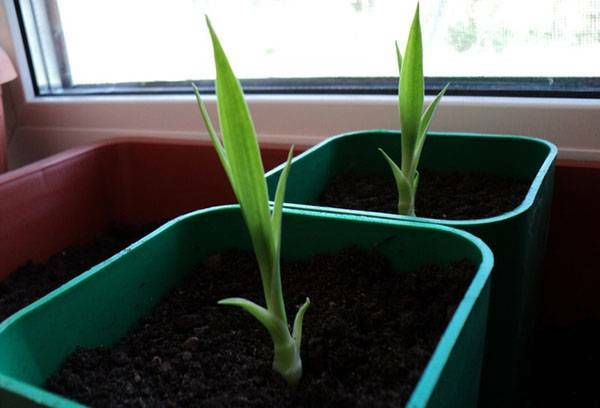
Propagation by air layers
Propagation of dracaena by air layers is almost as common as propagation by cuttings.
- Inspect the trunk of the dracaena. In one of the places where the sheet used to be, make a lateral incision approximately to the middle of the trunk.
- Insert a toothpick or match in the cut so that it does not become overgrown.
- Wrap the incision site with peat moss( sphagnum).
- Moisten the moss with water from the spray gun.
- Wrap the moss with cellophane. Do not let it dry, sprinkling periodically.
- When the roots begin to germinate, the film can be removed, and the young plant can be cut and planted in a pot.
There is a high probability that on the stem under the cutting site, by this time, new sprouts are already forming.

Propagation by seeds
Flowering of the dracaena is a rare fortune. If the flower grower managed to achieve flowering, do not miss the opportunity to grow from the seeds of many young dracen. Wait for the end of February - early March and proceed.
- For each seed, prepare a glass by making a drainage hole in it, pouring drainage on the bottom, on top is the dracen soil from the flower shop.
- Make grooves in the soil - at least 5 mm, but not more than 1 cm.
- In the pits, put seeds, sprinkle with earth, pour.
- The pots are covered with a film put in a warm place. The optimum temperature is 25-27 degrees. Do not forget to water and air.
- When the seedlings appear( it will happen in 30-40 days), remove the film.
When the length of the shoots reaches 5 cm, they should be transplanted into larger pots, where they will grow permanently. First, shelter them from direct sunlight, make sure that the soil does not dry out, but it is not too wet. Keep the room temperature at 23-25 degrees. In six months, the fate of young palm trees can not be worried - care for them will be needed the same as for the adult dracenas.
Reproduction of dracena at home is a realistic task, feasible even for inexperienced growers. The main thing is to choose the appropriate method and follow the instructions clearly, realizing that even a small detail is sometimes crucial. There are four methods of propagation of dracaena. The easiest and most reliable way is to grow young palm trees from stem cuttings, but in this case you will say goodbye to the palm itself. A more gentle way is to grow a plant from the top of the palm. This method is similar to the multiplication by air layers - it is slightly more troublesome, but much more reliable. The best way to reproduce the dracaena is by seeds, but getting a planting material is a great success, since the flowering of the dracaena at home is a rare phenomenon.


